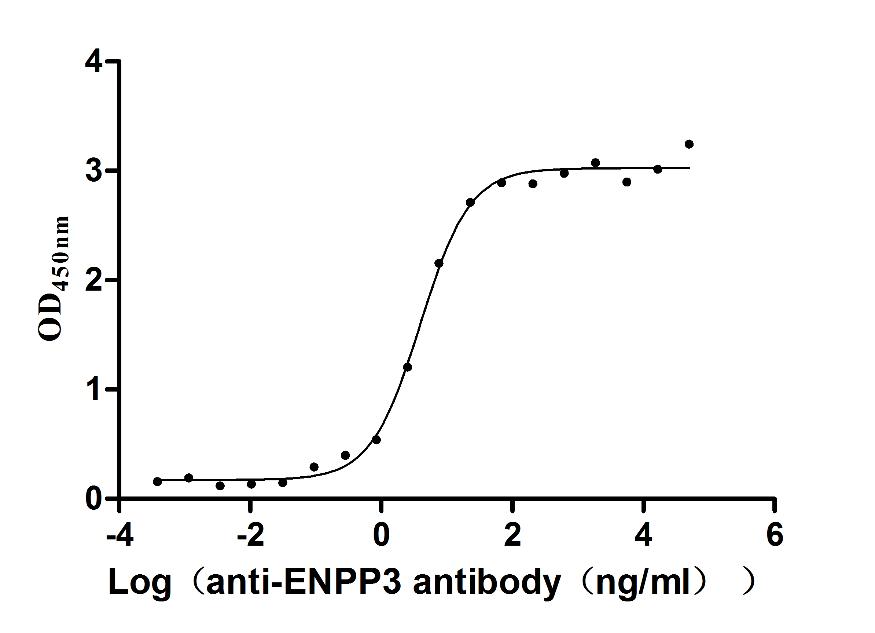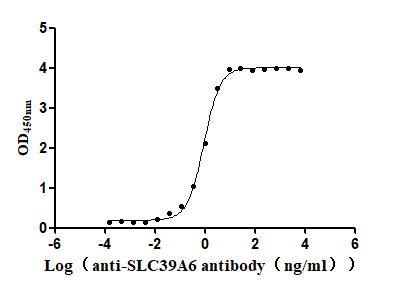Recombinant Mouse DNA repair protein XRCC4 (Xrcc4)
-
中文名称:小鼠Xrcc4重组蛋白
-
货号:CSB-YP849756MO
-
规格:
-
来源:Yeast
-
其他:
-
中文名称:小鼠Xrcc4重组蛋白
-
货号:CSB-EP849756MO
-
规格:
-
来源:E.coli
-
其他:
-
中文名称:小鼠Xrcc4重组蛋白
-
货号:CSB-EP849756MO-B
-
规格:
-
来源:E.coli
-
共轭:Avi-tag Biotinylated
E. coli biotin ligase (BirA) is highly specific in covalently attaching biotin to the 15 amino acid AviTag peptide. This recombinant protein was biotinylated in vivo by AviTag-BirA technology, which method is BriA catalyzes amide linkage between the biotin and the specific lysine of the AviTag.
-
其他:
-
中文名称:小鼠Xrcc4重组蛋白
-
货号:CSB-BP849756MO
-
规格:
-
来源:Baculovirus
-
其他:
-
中文名称:小鼠Xrcc4重组蛋白
-
货号:CSB-MP849756MO
-
规格:
-
来源:Mammalian cell
-
其他:
产品详情
-
纯度:>85% (SDS-PAGE)
-
基因名:Xrcc4
-
Uniprot No.:
-
别名:Xrcc4; DNA repair protein XRCC4; X-ray repair cross-complementing protein 4
-
种属:Mus musculus (Mouse)
-
蛋白长度:full length protein
-
表达区域:1-326
-
氨基酸序列MERKVSRIYL ASEPNVPYFL QVSWERAIGS GFVITLTDGH SAWTATVSEL EISQEADDMA MEKGKYIDEL RKALVPGSGA AGTYKFLFSK ESQHFSLEKE LKDVSFRLGS FNLDKVSNSA EVIRELICYC LDTITEKQAK NEHLQKENER LLRDWNDVQG RFEKCVSAKE ALEADLYQRF ILVLNEKKTK IRSLHKLLNE VQQLEESTKP ERENPCSDKT PEEHGLYDGS TDEESGAPVQ AAETLHKDDS IFSSPDVTDI APSRKRRHRM QKNLGTEPKM APQELPLQEK ERLASSLPQT LKEESTSAEN MSLETLRNSS PEDLFD
-
蛋白标签:Tag type will be determined during the manufacturing process.
The tag type will be determined during production process. If you have specified tag type, please tell us and we will develop the specified tag preferentially. -
产品提供形式:Lyophilized powder
Note: We will preferentially ship the format that we have in stock, however, if you have any special requirement for the format, please remark your requirement when placing the order, we will prepare according to your demand. -
复溶:We recommend that this vial be briefly centrifuged prior to opening to bring the contents to the bottom. Please reconstitute protein in deionized sterile water to a concentration of 0.1-1.0 mg/mL.We recommend to add 5-50% of glycerol (final concentration) and aliquot for long-term storage at -20℃/-80℃. Our default final concentration of glycerol is 50%. Customers could use it as reference.
-
储存条件:Store at -20°C/-80°C upon receipt, aliquoting is necessary for mutiple use. Avoid repeated freeze-thaw cycles.
-
保质期:The shelf life is related to many factors, storage state, buffer ingredients, storage temperature and the stability of the protein itself.
Generally, the shelf life of liquid form is 6 months at -20°C/-80°C. The shelf life of lyophilized form is 12 months at -20°C/-80°C. -
货期:Delivery time may differ from different purchasing way or location, please kindly consult your local distributors for specific delivery time.Note: All of our proteins are default shipped with normal blue ice packs, if you request to ship with dry ice, please communicate with us in advance and extra fees will be charged.
-
注意事项:Repeated freezing and thawing is not recommended. Store working aliquots at 4°C for up to one week.
-
Datasheet :Please contact us to get it.
靶点详情
-
功能:DNA non-homologous end joining (NHEJ) core factor, required for double-strand break repair and V(D)J recombination. Acts as a scaffold protein that regulates recruitment of other proteins to DNA double-strand breaks (DSBs). Associates with NHEJ1/XLF to form alternating helical filaments that bridge DNA and act like a bandage, holding together the broken DNA until it is repaired. The XRCC4-NHEJ1/XLF subcomplex binds to the DNA fragments of a DSB in a highly diffusive manner and robustly bridges two independent DNA molecules, holding the broken DNA fragments in close proximity to one other. The mobility of the bridges ensures that the ends remain accessible for further processing by other repair factors. Plays a key role in the NHEJ ligation step of the broken DNA during DSB repair via direct interaction with DNA ligase IV (LIG4): the LIG4-XRCC4 subcomplex reseals the DNA breaks after the gap filling is completed. XRCC4 stabilizes LIG4, regulates its subcellular localization and enhances LIG4's joining activity. Binding of the LIG4-XRCC4 subcomplex to DNA ends is dependent on the assembly of the DNA-dependent protein kinase complex DNA-PK to these DNA ends. Promotes displacement of PNKP from processed strand break termini.; Acts as an activator of the phospholipid scramblase activity of XKR4. This form, which is generated upon caspase-3 (CASP3) cleavage, translocates into the cytoplasm and interacts with XKR4, thereby promoting phosphatidylserine scramblase activity of XKR4 and leading to phosphatidylserine exposure on apoptotic cell surface.
-
基因功能参考文献:
- These data imply that the level of XRCC4 expression could be used to predict the effects of apoptosis-inducing drugs in cancer treatment. PMID: 29233683
- involvement of ZNF281 in the cellular response to genotoxic stress through the control exercised on the expression of genes that act in different repair mechanisms PMID: 26300006
- We find that non-canonical HR termination can occur in the absence of the classical non-homologous end joining gene XRCC4. We observe obligatory use of microhomology (MH)-mediated end joining and/or nucleotide addition during rejoining with the second end of the break PMID: 27832076
- Data show that combined deletion of X-ray repair cross-complementing protein 4 (Xrcc4) and tumor suppressor p53 (Trp53) predisposes B cells to lymphomagenesis. PMID: 26740101
- FBXW7 facilitates nonhomologous end-joining via K63-linked polyubiquitylation of XRCC4 in tumor cells. PMID: 26774286
- The present results collectively indicated that Lys271, but not Lys210, of XRCC4 is required for the nuclear localization of XRCC4 and LIG4 and that the nuclear localizing ability is essential for DSB repair function of XRCC4. PMID: 25934149
- DNA-PK and ATM acts in parallel upstream of XRCC4, regulating through phosphorylation PMID: 25391321
- XRCC4 C-terminal point mutants, R325F and N326L, are functionally deficient in terms of cell survival after irradiation. PMID: 25597996
- These results establish that nonrecurrent CNVs can be, and frequently are, formed by mechanisms other than Xrcc4-dependent NHEJ. PMID: 23028374
- analysis of the association of radiation-induced XRCC4 with chromatin DNA, by biochemical fractionation PMID: 20448413
- conditional inactivation of the XRCC4 in nestin-expressing neuronal progenitor cells, although leading to no obvious phenotype in a WT background, leads to early onset of neuronally differentiated medulloblastomas (MBs) in a p53-deficient background PMID: 16670198
- DNA-PK kinase activity results in disassembly of the Ku/DNA ligase IV/Xrcc4 complex PMID: 17241822
- Connection of XRCC4 and the nonhomologous end joining DNA repair pathway to immunoglobulin class switch recombination. PMID: 17606631
- the KU80/XRCC4 pathway is conservative and not intrinsically error-prone but can accommodate non-fully complementary ends at the cost of limited mutagenesis PMID: 18093953
- A report on the chromosomal repair phenotype of XRCC4 null mouse cells. PMID: 18332040
- Data suggest that Xrcc4/p53-deficient pro-B lymphomas routinely activate c-myc by gene amplification, whereas Xrcc4/p53-deficient peripheral B cell lymphomas routinely ectopically activate a single c-myc copy. PMID: 19064702
- Data show that depletion of Mre11 reduces the use of microhomology during NHEJ in Xrcc4(+/+) cells and suppresses end resection in Xrcc4(-/-) cells, revealing specific roles for Mre11 in both classical and alternative NHEJ. PMID: 19633669
显示更多
收起更多
-
亚细胞定位:Nucleus. Chromosome.; [Protein XRCC4, C-terminus]: Cytoplasm.
-
蛋白家族:XRCC4 family
-
数据库链接:
KEGG: mmu:108138
STRING: 10090.ENSMUSP00000022115
UniGene: Mm.37531
Most popular with customers
-
Express system: Mammalian cell
Species: Macaca fascicularis (Crab-eating macaque) (Cynomolgus monkey)
-
Recombinant Human Lymphocyte antigen 6 complex locus protein G6d (LY6G6D) (Active)
Express system: Yeast
Species: Homo sapiens (Human)
-
Recombinant Human Desmoglein-3 (DSG3), partial (Active)
Express system: Baculovirus
Species: Homo sapiens (Human)
-
Recombinant Human Claudin-3 (CLDN3)-VLPs (Active)
Express system: Mammalian cell
Species: Homo sapiens (Human)
-
Recombinant Human C-C chemokine receptor type 8 (CCR8)-VLPs (Active)
Express system: Mammalian cell
Species: Homo sapiens (Human)
-
Recombinant Human Dipeptidase 3(DPEP3), partial (Active)
Express system: Mammalian cell
Species: Homo sapiens (Human)
-
Recombinant Human Cadherin-6(CDH6),partial (Active)
Express system: Mammalian cell
Species: Homo sapiens (Human)
-
Recombinant Macaca fascicularis Zinc transporter ZIP6 isoform X1(SLC39A6),partial (Active)
Express system: Baculovirus
Species: Macaca fascicularis (Crab-eating macaque) (Cynomolgus monkey)




















